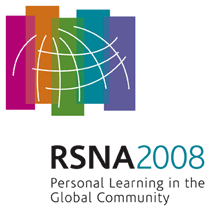
Abstract Archives of the RSNA, 2008
SSM19-04
Multimodality Imaging of Atherosclerosis Using PET/CT and MRI in Carotid and Femoral Arteries
Scientific Papers
Presented on December 3, 2008
Presented as part of SSM19: Nuclear Medicine (Cardiovascular)
 Research and Education Foundation Support
Research and Education Foundation Support
Stéphane Silvera MD, Presenter: Nothing to Disclose
Hamza el Aidi MD, Abstract Co-Author: Nothing to Disclose
James Rudd MD, PhD, Abstract Co-Author: Nothing to Disclose
Kelly Myers MD, Abstract Co-Author: Nothing to Disclose
Venkatesh Mani PhD, Abstract Co-Author: Nothing to Disclose
Zahi Adel Fayad PhD, Abstract Co-Author: Research grant, Merck & Co, Inc
Research grant, Pfizer Inc
Research grant, F. Hoffmann-La Roche Ltd (Roche Diagnostics)
Research grant, Takeda Pharmaceutical Company Limited
Research grant, DAIICHI SANKYO Group
Research grant, Siemens AG
Research grant, VIA Pharmaceuticals, Inc
Research grant, Guerbet SA
Research Consultant, Merck & Co, Inc
Research Consultant, VIA Pharmaceuticals, Inc
Research Consultant, BG Medicine, Inc
Ash Rafique, Abstract Co-Author: Nothing to Disclose
et al, Abstract Co-Author: Nothing to Disclose
To evaluate the relationship between atherosclerotic plaque inflammation, as assessed by FDG-Positron Emission Tomography/Computed Tomography (FDG-PET/CT), and plaque morphology, as assessed by magnetic resonance imaging (MRI), in the carotid and femoral arteries.
16 patients gave informed consent to undergo FDG-PET/CT and MRI in the region of known atherosclerotic disease in this IRB-approved, HIPAA-compliant study. For every slice along the length of the arteries, two observers determined the corresponding regions of the FDG-PET/CT and MRI image sets by qualitatively matching CT and T2 weighted (T2WI) axial images. After coregistration, every plaque was classified into three groups according to the CT appearance and T2W/PDW signal: 1) collagen group, 2) lipid-necrotic core group and 3) calcium group.
Arterial FDG uptake was measured by drawing a region of interest (ROI) on each artery on every slice of the PET/CT images. The mean arterial standardized uptake value (SUV) of the entire artery was standardized by the average of the vein activity to produce a blood-corrected artery activity named target to background ratio (TBR). The vessel wall thickness (VWT), the vessel wall area (VWA) and the total vessel wall area (TVW) were also measured on T2WI. Differences in TBR between the three groups were assessed using a Mann-Whitney test, and correlation between TBR and VWT were assessed by Pearson test.
The TBR value was significantly higher in the lipid-necrotic core group compared to the collagen and calcium groups, (p < 0.001). The lipid-necrotic core group demonstrated a significant TBR variation according to the median of the VWT (TBR = 1.26 ± 0.25 vs. TBR = 1.50 ± 0.12). There was no correlation with the others quantitative MR parameters.
Our study demonstrates for the first time the relationship between high FDG uptake and lipid necrotic core assessed by MRI.
Using both imaging methods could offer a unique, non-invasive method to characterize plaque composition, to measure plaque inflammation and to adapt the appropriate medical therapeutic.
Silvera, S,
el Aidi, H,
Rudd, J,
Myers, K,
Mani, V,
Fayad, Z,
Rafique, A,
et al, ,
Multimodality Imaging of Atherosclerosis Using PET/CT and MRI in Carotid and Femoral Arteries. Radiological Society of North America 2008 Scientific Assembly and Annual Meeting, February 18 - February 20, 2008 ,Chicago IL.
http://archive.rsna.org/2008/6020309.html
Accessed September 23, 2025


 Research and Education Foundation Support
Research and Education Foundation Support